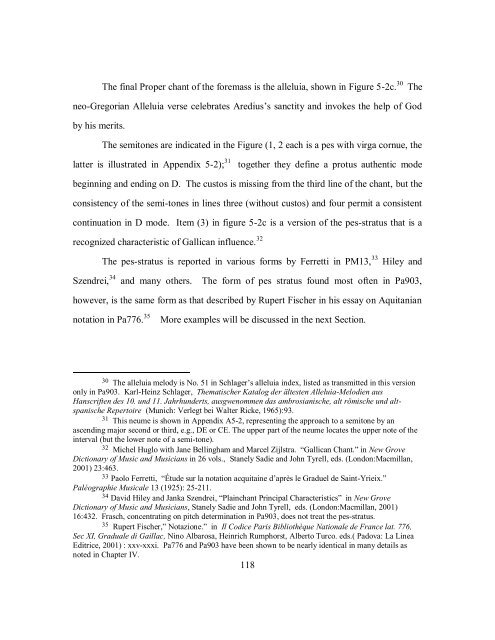Front Matter Template - The University of Texas at Austin
Front Matter Template - The University of Texas at Austin
Front Matter Template - The University of Texas at Austin
You also want an ePaper? Increase the reach of your titles
YUMPU automatically turns print PDFs into web optimized ePapers that Google loves.
<strong>The</strong> final Proper chant <strong>of</strong> the foremass is the alleluia, shown in Figure 5-2c. 30 <strong>The</strong><br />
neo-Gregorian Alleluia verse celebr<strong>at</strong>es Aredius‟s sanctity and invokes the help <strong>of</strong> God<br />
by his merits.<br />
<strong>The</strong> semitones are indic<strong>at</strong>ed in the Figure (1, 2 each is a pes with virga cornue, the<br />
l<strong>at</strong>ter is illustr<strong>at</strong>ed in Appendix 5-2); 31 together they define a protus authentic mode<br />
beginning and ending on D. <strong>The</strong> custos is missing from the third line <strong>of</strong> the chant, but the<br />
consistency <strong>of</strong> the semi-tones in lines three (without custos) and four permit a consistent<br />
continu<strong>at</strong>ion in D mode. Item (3) in figure 5-2c is a version <strong>of</strong> the pes-str<strong>at</strong>us th<strong>at</strong> is a<br />
recognized characteristic <strong>of</strong> Gallican influence. 32<br />
<strong>The</strong> pes-str<strong>at</strong>us is reported in various forms by Ferretti in PM13, 33 Hiley and<br />
Szendrei, 34 and many others. <strong>The</strong> form <strong>of</strong> pes str<strong>at</strong>us found most <strong>of</strong>ten in Pa903,<br />
however, is the same form as th<strong>at</strong> described by Rupert Fischer in his essay on Aquitanian<br />
not<strong>at</strong>ion in Pa776. 35 More examples will be discussed in the next Section.<br />
30 <strong>The</strong> alleluia melody is No. 51 in Schlager’s alleluia index, listed as transmitted in this version<br />
only in Pa903. Karl-Heinz Schlager, <strong>The</strong>m<strong>at</strong>ischer K<strong>at</strong>alog der ältesten Alleluia-Melodien aus<br />
Hanscriften des 10. und 11. Jahrhunderts, ausgwenommen das ambrosianische, alt römische und altspanische<br />
Repertoire (Munich: Verlegt bei Walter Ricke, 1965):93.<br />
31 This neume is shown in Appendix A5-2, representing the approach to a semitone by an<br />
ascending major second or third, e.g., DE or CE. <strong>The</strong> upper part <strong>of</strong> the neume loc<strong>at</strong>es the upper note <strong>of</strong> the<br />
interval (but the lower note <strong>of</strong> a semi-tone).<br />
32 Michel Huglo with Jane Bellingham and Marcel Zijlstra. “Gallican Chant.” in New Grove<br />
Dictionary <strong>of</strong> Music and Musicians in 26 vols., Stanely Sadie and John Tyrell, eds. (London:Macmillan,<br />
2001) 23:463.<br />
33 Paolo Ferretti, “Étude sur la not<strong>at</strong>ion acquitaine d’après le Graduel de Saint-Yrieix.”<br />
Paléographie Musicale 13 (1925): 25-211.<br />
34 David Hiley and Janka Szendrei, “Plainchant Principal Characteristics” in New Grove<br />
Dictionary <strong>of</strong> Music and Musicians, Stanely Sadie and John Tyrell, eds. (London:Macmillan, 2001)<br />
16:432. Frasch, concentr<strong>at</strong>ing on pitch determin<strong>at</strong>ion in Pa903, does not tre<strong>at</strong> the pes-str<strong>at</strong>us.<br />
35 Rupert Fischer,” Notazione.” in Il Codice Paris Bibliothèque N<strong>at</strong>ionale de France l<strong>at</strong>. 776,<br />
Sec XI, Graduale di Gaillac, Nino Albarosa, Heinrich Rumphorst, Alberto Turco. eds.( Padova: La Linea<br />
Editrice, 2001) : xxv-xxxi. Pa776 and Pa903 have been shown to be nearly identical in many details as<br />
noted in Chapter IV.<br />
118

















